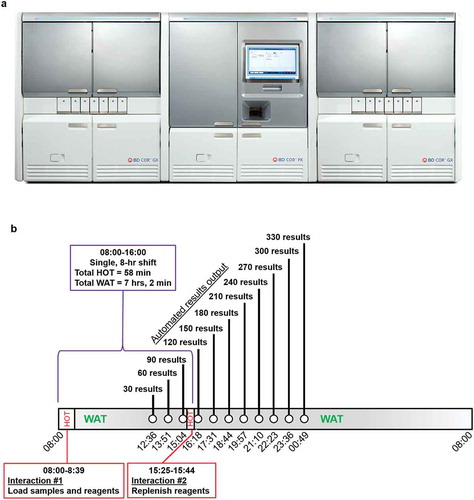Figures & data
Figure 1. (a) PX, GX, and MX modules that constitute the BD COR system. The PX module automates pre-analytical sample processing and associated steps for each sample type. The PX module is the operational core of the system, upon which the GX module depends. This instrument is specifically designed to automatically perform a number of manual steps that are similar to Viper LT sample processing. All specimen loading and unloading occurs at the PX instrument. Pre-analytical steps performed via the PX include sample vortexing, aliquoting clinical specimens into a molecular tube with the correct diluent, sorting/grouping of samples, sample pre-warming and cooling (where required), and sample transport to the GX module. Automated extraction and amplification/detection occurs within the GX module. GX is designed to perform the Onclarity Assay using core technology that exists in the Viper LT system; however, GX is designed for a larger capacity. The MX module can also be utilized with PX to perform various molecular assays for diagnostic purposes that are not specifically addressed in this report. The COR system allows for multiple configurations that are centered on the PX module including GX:PX:MX, GX:PX:GX, MX:PX:MX, GX:PX, and MX:PX. (1b). Throughput of specimen processing and analysis via PX-GX modules within the BD COR System. GX throughput was validated as part of this study and is capable of delivering 330 HPV results in an 8-hour shift, with just two contact points – one in the morning to load samples and reagents, and a second brief interaction in the afternoon to replenish supplies to enable the system to complete this number of specimens

Table 1. Variance component analysis – site to site reproducibility for the Onclarity assay results on the COR system
Table 2. Performance agreement with specimen type for Onclarity results between COR and Viper LT systems – PPA, NPA, and OPA
Table 3. Positive percent agreement with HPV genotype using the Onclarity assay on the COR system versus the Viper LT system
Figure 2. Deming regression plots which represent linear regression, incorporates values for errors in observations generated by both Viper LT (x-axis) and COR (y-axis) for (a) SurePath, (b) PreservCyt, and (c) CBD media types are shown. All specimen results with a Ct value <40 were included in the analysis shown

Table 4. Ct score comparisons for Onclarity assay results between the COR system and the Viper LT system
